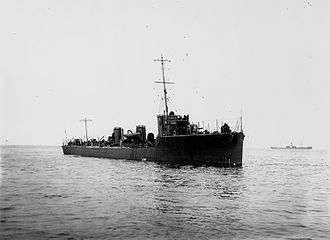HMS Shark (1912)
 HMS Shark | |
| History | |
|---|---|
| Name: | HMS Shark |
| Builder: | Swan, Hunter & Wigham Richardson, Wallsend |
| Launched: | 30 July 1912 |
| Fate: | Sunk, Battle of Jutland, 31 May 1916 |
| General characteristics | |
| Class and type: | Acasta-class destroyer |
| Length: | 267 ft 6 in (81.53 m) |
| Beam: | 27 ft (8.2 m) |
| Draught: | 10 ft 6 in (3.20 m) |
| Propulsion: | Yarrow-type water-tube boilers, Parsons steam turbines |
| Speed: | 29 kts |
| Armament: |
|
HMS Shark, was an Acasta-class destroyer built in 1912 and sunk during the Battle of Jutland on the evening of 31 May 1916.
Construction
She was built at the Wallsend yard of Swan, Hunter & Wigham Richardson and launched on 30 July 1912. She joined the 4th Destroyer Flotilla on completion.
Service during World War I
Shark served with the Grand Fleet from the outbreak of World War I.
The Battle of Jutland
During the Battle of Jutland, the 4th Flotilla was attached to Admiral David Beatty's Battlecruiser Fleet based at Rosyth, and assigned to cover the 3rd Battlecruiser Squadron. During the battle, at around 6 pm, Shark led an unsuccessful torpedo attack by the flotilla on the German 2nd Scouting Group. The other three destroyers escaped with little damage, but Shark was crippled by gunfire.[1] The forecastle gun was completely blown away with most of its gun crew shortly before the captain, Commander Loftus Jones, declined an offer of assistance from the destroyer Acasta.
Soon afterwards the aft 4 inch gun was also destroyed and the bridge wrecked. Jones and three seamen continued working the midship gun, engaging nearby German destroyers and leading to the sinking of V48.[2] The German destroyers closed on the ship and returned heavy fire, during which Jones lost a leg. Shortly before 7 pm he ordered the ship to be abandoned and around thirty of the crew managed to get onto the rafts. Only seven were picked up six hours later by a Danish ship, but one died soon afterwards. Although there are reports that Jones went down with the ship,[3] survivors told his wife that he was put onto a raft.[4]
In total, 86 men out of a crew of 92 were killed.[5]
Loss
At 7 pm, the destroyer was sunk by a torpedo launched by the German torpedo boat S54 and which hit her abreast of the aft funnel. In March 1917, Jones was gazetted with a posthumous Victoria Cross.[2] The wrecksite is designated as a protected place[6] under the Protection of Military Remains Act 1986.
References
- ↑ N. J. Campbell (1987). Jutland: An analysis of the fighting. ISBN 0-85177-379-6.
- 1 2 "Biography: Loftus William Jones VC". Royal Naval Museum. Retrieved 2007-08-20.
- ↑ Nigel Steel & Peter Hart (2004). Jutland 1916: Death in the Grey Wastes. ISBN 0-304-36648-X.
- ↑ Public Records Office Northern Ireland. "Letter from Margaret Annie Jones to her Brother-in-law". Letters of 1916. Retrieved 18 February 2016.
- ↑ "Officers and Men Killed in Action H.M.S. Shark, Jutland Bank, 31st May 1916".
- ↑ "Statutory Instrument 2008/0950". Office of Public Sector Information, 1 April 2008. Retrieved 2008-07-19.
Coordinates: 56°58′30″N 06°03′00″E / 56.97500°N 6.05000°E